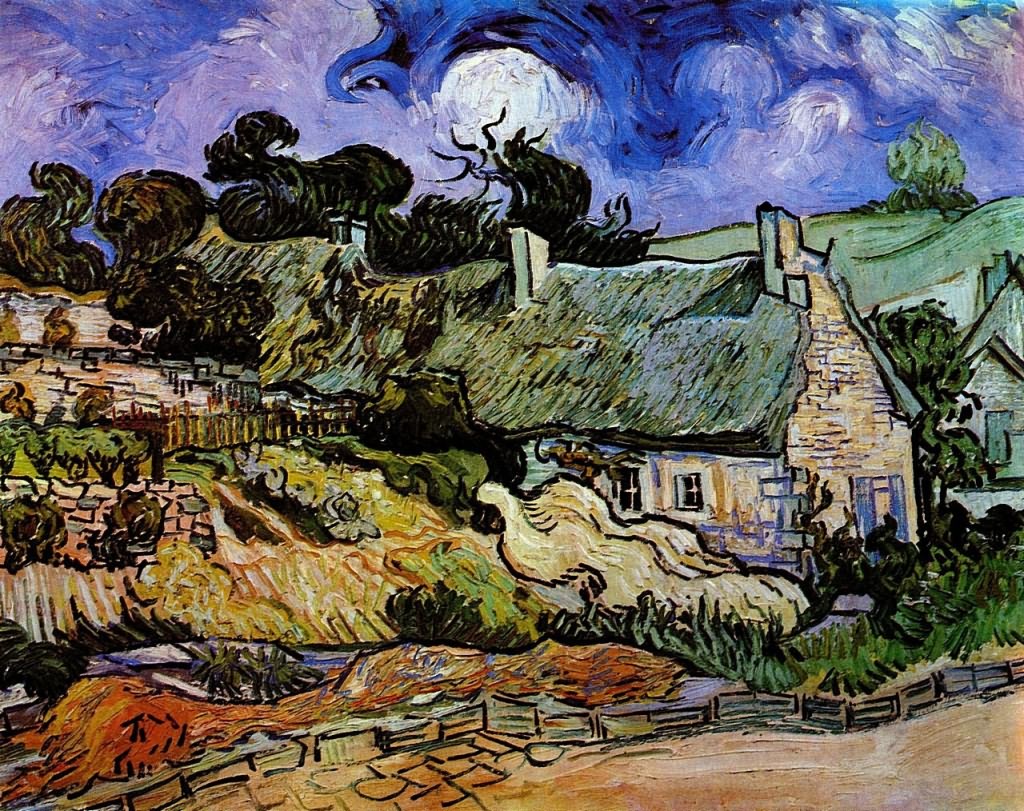Houses with Thatched Roofs, Cordeville
Appreciation

Houses with Thatched Roofs, Cordeville Nederland Vincent van Gogh Gallery and Appreciation
After more than a year in voluntary confinement at the Saint-Paul-de-Mausole asylum in Saint-Rémy, France, Vincent van Gogh moved to the village of Auvers-sur-Oise on 20 May 1890. With Auvers' proximity to Paris, Van Gogh would be much closer to his brother Theo as well as Theo's wife, Johanna, and their newborn son. Van Gogh also felt reassured (at least initially) that he would be under the capable care of the homeopathic physician Dr. Paul Gachet.
Upon his arrival in Auvers, Van Gogh was immediately delighted with its environs. On the day of his arrival he wrote to Theo and Johanna in Paris with great enthusiasm:
Auvers is really beautiful ‚Ä?among other things many old thatched roofs, which are becoming rare.
I‚Äôd hope, then, that in doing a few canvases of that really seriously, there would be a chance of recouping some of the costs of my stay ‚Ä?for really it‚Äôs gravely beautiful, it‚Äôs the heart of the countryside, distinctive and picturesque.
Letter 635
Van Gogh also wrote to his sister Willemien about his pleasure with the Auvers countryside:
And as for myself, for the moment I still fear the noise and the bustle of Paris and I left immediately for the country ‚Ä?to an old village.
Here there are roofs of mossy thatch which are superb, and of which I’ll certainly do something.
Letter W21
Van Gogh would delight in his exploration of Auvers-sur-Oise and in June he would write to Theo and Jo "I’ve done two studies of houses in the greenery" (Letter 640). It's uncertain if Van Gogh was referring specifically to Thatched Cottages at Cordeville (the other candidates being Houses in Auvers: both F 759 and F 805). Whatever the case, Van Gogh's enthusiasm for the subject is clear and he undertook the painting of this cottage in Cordeville, a small hamlet near Auvers, with great passion.
In a number of earlier works Van Gogh would brilliantly use contrasting colours to bring vibrant life to his canvases. In Thatched Cottages at Cordeville, however, one sees a harmonious symphony of blues and greens. The lush fields flow like a gently rolling ocean and the bushes adjacent to the cottage move with flame-like fluidity. Even the cottage itself seamlessly blends into the landscape--an integral and organic wholeness that makes this painting so remarkable.
Trivia
Thatched Cottages at Cordeville figures prominently in Frank Herbert's Dune science fiction series. The painting is one of the only objects to survive from Earth. In Hunters of Dune (written by Brian Herbert and Kevin J. Anderson) the work is mentioned once again. The following passage is set more than 26,000 years in the future:
The Van Gogh painting hung on a metal wall of Sheeana's cabin. She had stolen the masterpiece from the Mother Superior's quarters before escaping from Chapterhouse. Of all the crimes she had committed during her flight, taking the Van Gogh was her only selfish and unjustified act. For years, she had drawn comfort from this great work of art and everything it represented.
With the glowpanels adjusted to perfect illumination, Sheeana stood unblinking before the masterpiece. Though she had studied the painting meticulously many times, she still gained new insight from the daubs of bright paint, the thick brushstrokes, the chaotic flurry of creative energy. A deeply disturbed man, Van Gogh had turned these splotches and smudges of color into a work of genius. Could pure, cold sanity have done as much?
Thatched Cottages at Cordeville had survived the atomic destruction of Earth ages ago, the Butlerian Jihad and ensuing dark ages, then Muad'Dib's Jihad, thirty-five hundred years of the Tyrant's rule, the Famine Times, and the Scattering. Without doubt, this fragile piece of art was blessed.
(page 201)